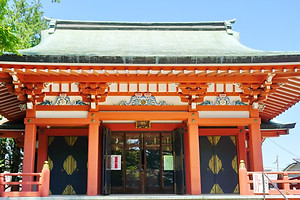普通の外にいくつかの著名な品質を持っている、と畏敬の念を起こさせるあるいかなるビーイングは、カミと呼ばれています。

homepage
六所神社
Google Map
Tōkyō-to, Setagaya-ku, Noge 2-14-2 東京都世田谷区野毛2-14-2 May 4, 2018
Rokusho Jinja
Nearest station: Todoroki Line: Tōkyū-Oimachi Line
Enshrined Kami:
Main
(Note: numbers in parentheses after kami names
refer to position in How Many Kami table)
From Merged Shrines
Homuda-wake-no-mikoto 品陀和氣命
Ōyamatsumi-mikoto 大山都見命
In-ground Shrines:
Sui Jinja 水神社
Kitano Jinja 北野神社
Annual Festival: 4th Saturday/Sunday of September
History
This shrine is said to have come into existence when the Tamagawa river flooded its banks sometime during the Genna Period (1615-1624). A hokora (small shrine) apparently came floating downstream and was caught in a tree. The local people commemorated this by calling the hokora Ōkunitama Jinja with Fuchū Rokusho-Myōjin as its kami (Fuchū was upstream from Noge and was the home of Ōkunitama Jinja, the Ichinomiya of Musashino Province). The shrine's betto-ji was a temple called Zenryō-ji, which was then and is now less than 200m south of the shrine.
In 1890 four local shrines--Yamagiwa Jinja (山際神社), Hiei JInja (日枝神社), Usa JInja (宇佐神社and Kitano Jinja--were merged into another


local shrine, Tenso Jinja, and this was in turn merged into the Rokusho Jinja in 1898; the new entity was then moved to its current location. In 1941 Hiei Jinja was demerged. By 1969 the shrine was showing its age and most of its buildings were replaced with ferro-concrete structures.
Description
The in-ground shrine, Sui Jinja, is of particular interest. On a stone memorial inside it there are some carvings in Sanskrit referring to Varuna, the vedic god of water and sky, who came into Buddhism as the god of water and protector of the west. In Japan he is known as Suiten (水天), and is particularly revered by the Shingon sect as one of the Twelve Vedas. After the Shin-butsu Bunri, Varuna was identified with Amenominaka-nushi.
(Click on images to expand them)










Sui Jinja 水神社











Kitano Jinja 北野神社








%20(1).jpg)